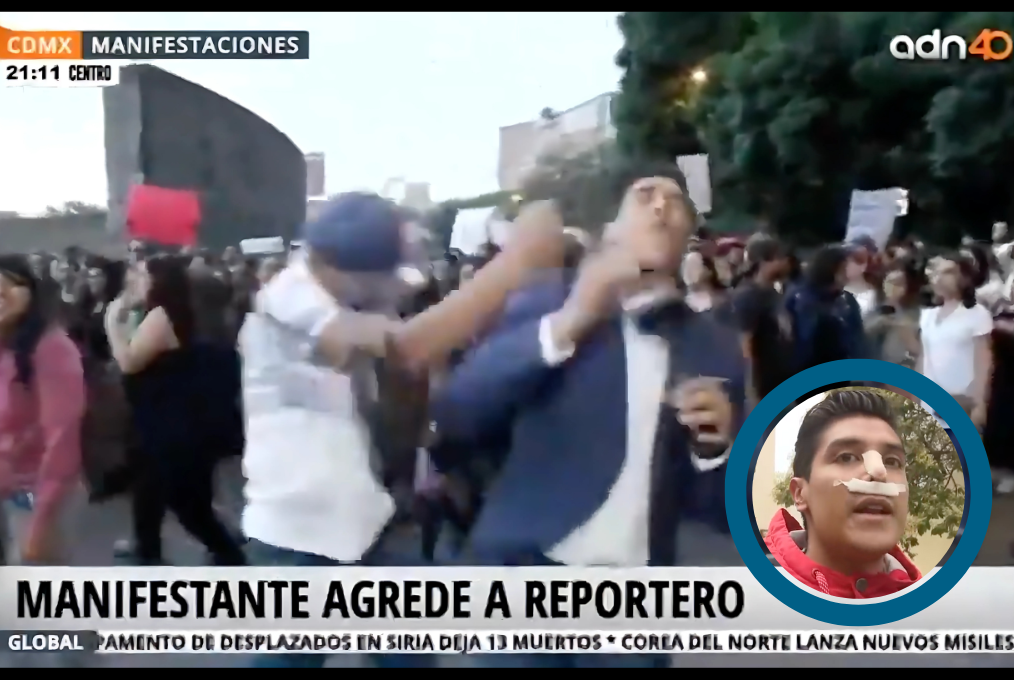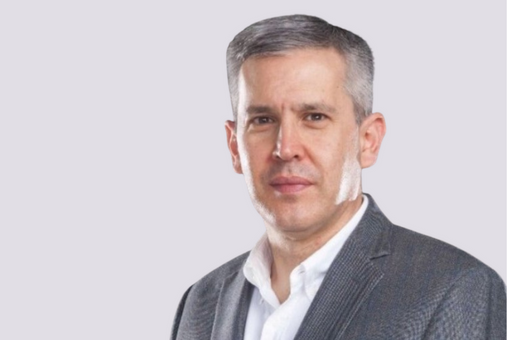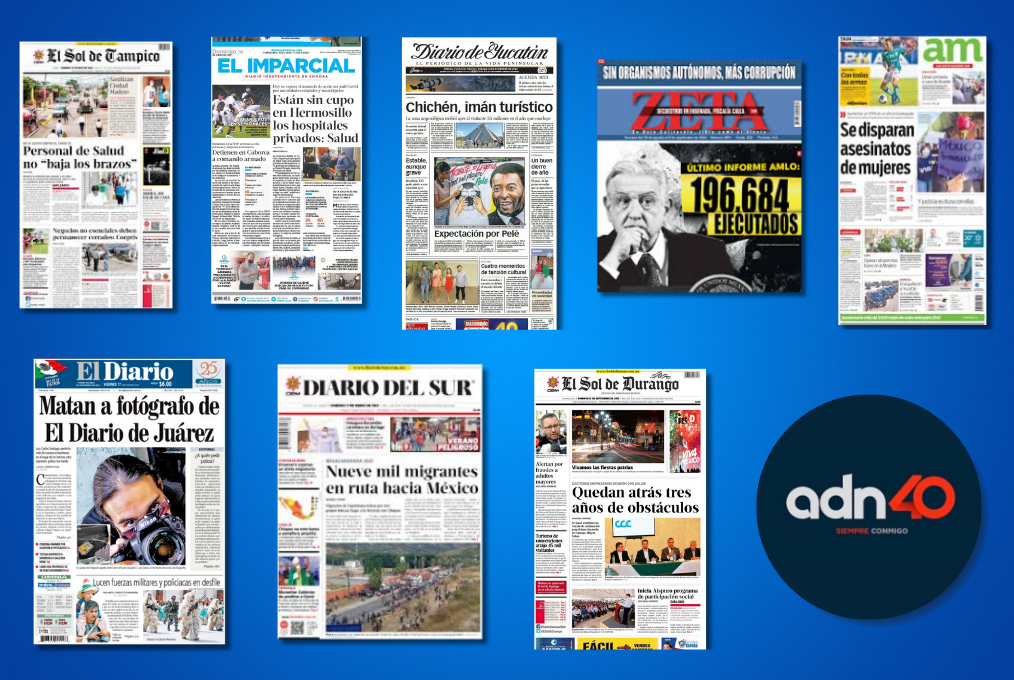Journalist Juan Manuel Jiménez, from Mexican news channel ADN 40, was hit in the face in 2019 while covering a feminist protest in Mexico City. After several protesters approached to yell at him, sprinkle colored powder on him and shout slogans into the microphone while Jiménez was broadcasting live, a man approached and punched him in the face, knocking him down.
The attack left the reporter with a fractured nasal septum that required surgical treatment.
The incident forced the ADN 40 newsroom to realize that, although levels of violence against journalists in the country's capital are not as high as in Mexican states plagued by organized crime, reporters from cities and large media outlets can also be targets of attacks.
“Before, the camera was respected, and reporters were more or less respected,” Leticia Martínez, information coordinator for ADN 40, told LatAm Journalism Review (LJR). “Perhaps our main concern is not necessarily running into drug traffickers, shootings, or situations of violence, but more so these attacks that come at us directly.”

The punch journalist Juan Manuel Jiménez received during a live broadcast caused him fracture of his nasal septum. (Photo: Screenshot from ADN 40's YouTube channel)
Martínez coordinated the ADN 40 team that participated in Safer Newsrooms (R+S, for its initials in Spanish), a training initiative on security for journalists organized by the Inter American Press Association (IAPA) and Google News Initiative (GNI).
The program, which ran for eight months this year, trained nine Mexican media outlets to create their own security protocols based on their specific needs and circumstances. The goal is to prevent attacks or be prepared for different types of attacks, amid an increasingly dangerous environment for the press in Mexico.
“When we approached this course, we said ‘we don’t have these kinds of situations here,’” Martínez said, referring to the risky conditions described during the program by journalists from outside Mexico City. “We felt alien to these circumstances, but little by little we realized that we weren’t. What happens is that perhaps [the attacks we are exposed to] are not as violent as in Celaya or Torreón.”
During the sessions, Martínez learned that her team needed to learn how to react in case that hostile environment toward the press was replicated in Mexico City. Martínez said that before the attack on Jiménez, her team had only experienced minor aggressions, such as the theft of a camera or surveillance by suspicious people while reporting in dangerous neighborhoods.
In addition to ADN 40, the newspapers selected to participate in the program include El Sol de Tampico, in the state of Tamaulipas; El Imparcial, in Sonora; Diario del Sur, in Chiapas; El Sol, in Durango; Diario AM, in León; El Sol, in Chihuahua; Diario de Yucatán, in Yucatán; and Semanario Zeta, in Baja California. All of these are located in dangerous regions, according to Carlos Lauría, executive director of the IAPA.
During the administration of former President Andrés Manuel López Obrador, which ended on Oct. 1, at least 47 journalists were killed in the country, while many more practiced their profession in an environment of threats and stigmatization.
“In the face of this democratic decline and acute polarization, this type of effort is essential,” Lauría told LJR. “These types of programs that help media outlets advance in these internal protocols, in these security plans that involve all areas of the newsroom, have been beneficial. In my experience, these types of programs can help prevent greater evils.”
The goal of Safer Newsrooms was not to teach journalists what they should do to prevent attacks. Rather, it was to teach them to identify the specific risks to which their newsroom is exposed and to design an action plan to prevent them and react if necessary.
“Each dynamic of violence is different, depending on the region. We are very clear that each region involves different challenges,” Javier Garza, a journalist specializing in security issues and coordinator of the program, told LJR. “The idea was to do a kind of exercise with different Mexican media outlets, not so much to tell them what kind of protection measures to take, but to show them a methodology so that they can create their own security protocol.”
Having the members of the newsroom staff design their own security plan gives them a certain sense of ownership towards the document and increases the chances of them adhering to it. That increases its effectiveness, Garza said.
“It’s not like Google specialists came and told them ‘these are the things you have to do,’ because in many cases that is seen as an imposition,” Garza said. “But if this is a document that your own team works on within the newsroom, you feel it is your own instrument, so you feel that it is something that you have to take care of and cultivate.”
Safer Newsrooms kicked off with a meeting with representatives of participating media outlets during the 79th IAPA General Assembly in December 2023 in Mexico City. There, they learned how the program would operate, Garza said. The initiative continued over the course of eight months with online training and mentoring sessions.
In the first sessions, participants learned how to conduct their own risk assessment, coordinated by Jorge Luis Sierra, a journalist and cybersecurity expert, as well as director of Border Hub, an organization dedicated to promoting quality investigative journalism in border regions between Mexico and the United States affected by corruption and violence.

Javier Garza, a journalist specializing in security issues, was the coordinator of the Safer Newsrooms initiative. (Photo: Archive)
Participants learned how to use Salama, the web platform Sierra developed that helps journalists and human rights defenders assess their personal and organizational security risks.
Salama works by using a questionnaire that journalists answer about their work environment and the type of threats and security measures that exist. Based on their answers, users receive concrete recommendations on how to improve their physical and digital security, as well as their personal well-being.
“A kind of analysis is made of strengths, weaknesses and vulnerabilities, and of who their potential attackers are and how they can harm them. Also, [it addresses] the form that the attacks can take and what kind of reporting leads to these attacks,” Garza said. “Maybe in Chiapas, the main threat may come from criminal groups, but for example in Chihuahua it may come from political actors. Each media outlet will have different forms of attack.”
An important part of the Safer Newsrooms methodology was the involvement of staff from areas other than the newsroom in the design of security protocols. To participate in the program, media outlets had to form multidisciplinary teams with members from areas such as administration, systems and human resources, as well as journalists and editors.
This is based on the understanding that for a plan to protect journalists on the ground to work, it must involve coordination of all areas of the media outlet.
“These internal security plans require the attention not only of journalists who cover sensitive topics, but also of editors, directors and those in administration who in many cases are responsible for providing or expediting resources so that journalists and the media outlet can respond to a risk,” Lauría said.
Safer Newsrooms also included training sessions on digital security, led by Google staff; physical security for journalists and facilities, taught by Garza; and gender perspective in security, led by journalist María Idalia Gómez.
Garza said one thing that stood out to him during the Safer Newsrooms sessions was that several of the teams realized they had not paid enough attention to potential attacks on their media facilities. Many did not have visitor control, video surveillance systems or trained guards in their buildings.
“They realized that it was an area of security that they didn’t think was important and it turned out to be important, because on several occasions we have seen [media] facilities attacked,” Garza said. “Or when a reporter is harassed or even abducted, they are followed from the offices.”
Garza said the teams agreed that they had all faced some kind of security threat that they had managed to protect themselves from in one way or another. However, he added, another goal of Safer Newsrooms was for participants to learn to systematize those practices that had worked for them and include them in their security protocols.
“The methodology is not just about putting security measures in place in response to a situation. It is also about putting security measures in place that perhaps they have been using for years, but had not done so systematically, or that perhaps one or two reporters followed, but that did not extend to the rest of the newsroom,” Garza said. “Now we are going to put it in a document so that it is systematic and so that every person who enters the newsroom, every new reporter or editor reads it, and that it is also constantly updated.”
The ADN 40 team is already putting this system into practice. For coverage of the presidential elections in Mexico in June of this year, Martínez developed a brief document with basic security measures for her reporters, which served as an exercise to finish outlining the general document with the security protocols for her media outlet.
Martinez said she will seek to integrate this general document into her newsroom style guide so that new staff members learn security protocols as part of their induction into how the channel operates.
Among the conclusions reached by the ADN 40 team after carrying out their risk analysis in the course is that the insecurity in Mexico City is a factor to be considered more seriously, since it could mainly affect reporters on the police and crime beat, Martínez said.

Eight local print media and one national TV channel in Mexico participated in the first edition of Safer Newsrooms. (Photo: Screenshots)
For journalists who work in investigations, transparency with sources is one of the main measures to take into account, in order to avoid the risk of misunderstandings or reprisals, she added.
The draft of the final document for ADN 40 includes measures such as outlining what should be done before, during and after reporting, previously investigating the location of the places where the team will travel, defining the most convenient way to move around and dress according to the conditions of the reporting, among others.
“We used to do things like that a bit intuitively: if I'm going to a prison, I obviously can't wear blue or khaki. If I'm going to a working-class neighborhood to report on criminals, I can't walk around with the [channel's] logos visible,” Martínez said. “And those are the kinds of elements that we had to consider for our methodology.”
Other security measures that Martínez plans to include in the ADN 40 security protocol are for journalists to do a quick sweep of each place they arrive at to try to identify emergency exits or escape routes in case of danger. They also determine who to call in case they need help and what to do if they encounter a hostile person.
“There are so many situations that can arise and during which we would not be able to react. And that is the main concern I have: that we all know how to act in different circumstances,” Martínez said. “My priority in doing this job is to cover many scenarios that allow me to have a wide range of reactions covered for when they go out to work.”
This first edition of Safer Newsrooms served as a pilot program to determine whether it was possible to carry out new editions to train more media outlets, and even replicate it in other parts of Latin America, Lauría said.
“We are in talks with Google to continue this program, because it has had important results,” he said. “There was a very positive reaction from the media involved and the idea is to be able to expand this to countries and areas where journalists and media outlets are not really prepared.”
Lauría said that among the territories where they are considering taking the program are Ecuador, where the press is facing growing threats due to organized crime, and regions of Argentina such as the city of Rosario, where more and more media outlets that cover drug trafficking are facing threats.
Garza added that in the future they might do similar training programs for independent journalists or founders of media outlets that exist on social networks, who are among the most vulnerable to violence in Mexico.
“Without a doubt, a methodology can emerge from here that can then be extended to other media or other journalists,” Garza said. “These are opportunities that we will take.”